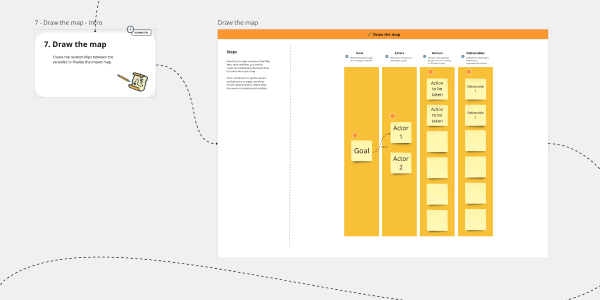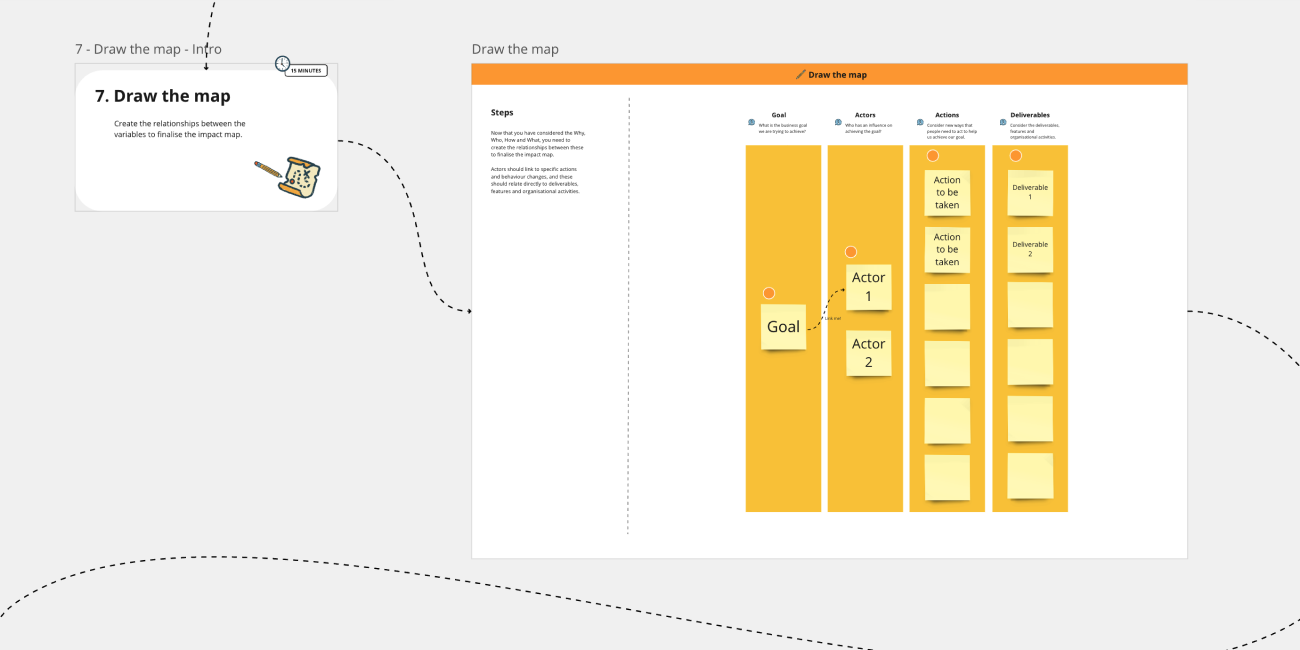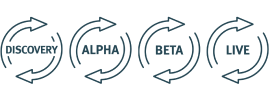Impact mapping
A successful project is one that makes an impact. Use this play as a strategic planning tool that illustrates customer and business goals, and links relevant actions and outcomes to those goals.
This play has been used effectively to illustrate how focused deliverables can create relevant short-term and long-term impacts. For example, in past projects, the deliverables centred around updates to the user flows in the service, which helped achieve the goal of increasing the number of customers who could self-serve after receiving an infringement notice.
It has also been used to develop long-term organisational strategies.
Impact mapping is fast, visual, and collaborative. It makes it easy to engage people from various roles and backgrounds, expose hidden assumptions and document important decisions. It provides just enough structure to facilitate effective planning and prioritisation.
Impact mapping is an advanced play. You may need to ask for help from a more experienced facilitator.

Outcomes
- Move from a vision to a goal, and align on the goal as a team
- Understand what actions need to happen to achieve the goal
- Connect deliverables to user needs
- Prevent scope creep by focusing on what is needed to achieve the goal
- Redefine existing initiatives
What you need
| Remote | In person |
|---|---|
|
|
Instructions
Create a vision
Impact Mapping works best when all players agree on the general outline of the problem at hand. Without a shared understanding of the problem, the play will fail.
Get input from a senior leader or the project owner to ensure the object of the play is understood by everyone involved before attempting the play. Don’t invite participants until you all have a shared understanding about the problem at hand. See other plays like journey mapping to develop this shared understanding.
Invite your participants
Participants in this session should be made up of the project team and any subject matter experts relevant to the project. This might include a Project Manager (PM), Project Officer, Designer, Business Analyst, Communications Officer, Solution Architect, or Developer. You’ll likely need to invite SMEs from policy, operational and customer service teams. Aim for including a range of people to form a multi-disciplinary team. You’ll want to make sure when you send an invite for the session, that you clearly explain the goal, how long it’ll take, and why people’s participation will be beneficial.
It’s important to give enough notice to ensure participants have free time to come along to the session. Aim to send invitations about 2 weeks in advance.
You can also attach the play for people to look at ahead of time.
Calendar meeting request for impact mapping
Subject:
Join us for an impact mapping workshop for [project name]
Meeting description:
Hi [team name if sending a group invitation, or participant name if sending individual invitations]
With our [name of project] work kicking off recently, we’re looking to do some strategic planning as a team to help align on our project goals and impacts.
The session will take about [x] minutes and there is no preparation required.
Having [you/each of you] attend will help to avoid assumptions in the planning process and align as a broader team on what success looks like. We will be using Miro for this workshop, and you can read more about the impact mapping session in the Digital service design playbook.
I look forward to your contribution to the session. [If you’re planning to record the session include the following - We will be recording the session for learning and development purposes and recordkeeping. Please let us know before the session if you don't want to be included in the recording or transcript].
Kind regards,
[Facilitator name]
1. Introduction – 10 mins
Welcome the team and start by explaining what each section of the template is all about, including the why, who, how and what.
If using Miro, check that everyone knows how to navigate and use the board.
2. Example walkthrough – 10 mins
Use the example impact map to explain what you are working toward in the workshop and why each element is important.
3. Goal setting – 30 mins total
Using a space in Miro, give the team time to reflect on articulating the core goal. The core goal will be an elaboration of the shared understanding of the problem at hand.
3a. Brainstorm – 10 mins
Give the team 10 mins to individually brainstorm goals on sticky notes.
Tip:
Focus on the why, not the what. Why are we doing this?
- No: Redesign the Mobile Phone and Seatbelt Technology services
- Yes: Increase the number of customers who can self-serve after receiving a mobile phone or seatbelt infringement by 20% over the current baseline.
3b. Discuss – 5 mins
Come together as a team to share and discuss the draft goals.
3c. Ideate to refine – 2 mins
Once everyone has shared their goals, work on refining the goal.
Questions to help people clarify the goal:
- Why do that?
- What’s the point?
- How would that be useful?
- What is the business objective?
Give everyone 2 minutes of ideation on post-its. Set a timer. Participants should try to answer the clarifying questions in full sentences or detailed phrases.
3d. Share back – 13 mins
Have them share what they wrote with the room. Remind them to write down other good ideas that come up in discussion, or you write them down.
A good goal at this point is SMART (Specific, Measurable, Actionable, Relevant and Time-bound). Another way to think about the goal is that it needs to be something where achieving the goal can be measured through data that TMR currently produces, collects, or can access.
Tip:
Goals that are stage gates, that is, a single thing to do that either does or does not exist, are probably too simple for this activity. Those are likely to be projects rather than goals.
Time for a break - 5 mins
DECISION POINT – the following two steps can be swapped based on the group of participants doing the workshop:
- If the people in the room are policy focused, do step 4 “what needs to happen”, then step 5 “what needs to be delivered”.
OR - If the people in the room are technical or implementation-focused, do step 5 “what needs to be delivered” next, then step 4 “what needs to happen”.
4. What needs to happen – 15 mins total
Here we consider new ways that people need to act to help us achieve our goal. Consider the actions that need to happen or behaviours that need to change to achieve the goal and succeed.
4a. Brainstorm – 5 mins
Individually brainstorm actions and behaviours for 5 minutes. Think about:
- How should people act differently to help us achieve our goal?
- What actions do our users need to take?
- What actions should internal stakeholders take to help us achieve our goal?
- How can anyone help us to achieve the goal?
- How can they obstruct or prevent us from succeeding?
4b. Cluster – 10 mins
Use the remaining 10 minutes to cluster as a team by grouping similar actions and behaviours together.
5. What needs to be delivered – 15 mins total
Once you have a clear goal, you can have a first look at scope.
5a. Brainstorm – 5 mins
For 5 minutes, individually brainstorm the deliverables, features and organisational activities. Think about what can we do, as an organisation or a delivery team, to help achieve the goal?
It’s likely that all players have some features or deliverables in mind. This is the time to get all of these written down and shared.
5b. Cluster – 10 mins
Use the remaining 10 minutes to cluster as a team. This means grouping similar answers together.
6. Determine the actors – 15 mins total
This step is about determining the actors who can influence the outcome. When we say 'actors' we mean people such as customers, stakeholders, and intermediaries who are affected by or influence whether we achieve our goal.
6a. Brainstorm – 5 mins
Individually brainstorm actors for 5 minutes. Think about different kinds of actors internally and externally:
- Who can produce the desired effect? E.g. designers and developers
- Who can obstruct it? E.g. Executives (giving or not giving approval)
- Who are the consumers or users of our product?
- Who will be impacted by it? E.g. customers
6b. Cluster – 10 mins
Use the remaining 10 minutes to cluster actors as a team. This means grouping similar actors together.
7. Draw the map – 15 mins
Now that you have considered the why, who, how and what, you need to create the relationships between these to finalise the impact map. Certain actors should link to specific actions and behaviour changes, and these should relate directly to deliverables, features and organisational activities.
The point of this part of the play is to make clear the logical relationships between goal, actors, behaviour changes and deliverables. When players link goals to actors and actors to behaviour changes, they are saying “to make it more likely to achieve this goal, this actor will have to act in this way”. If you have listed actors and behaviour changes that can’t be clearly and obviously linked to the goal, this is the time to drop them. Not everything needs to be on the final map.
Linking deliverables to behaviour changes is saying “this desirable behaviour (by this actor) is more likely to occur if we produce this deliverable”. If there are deliverables that aren’t obviously linked to behaviour changes, consider if they’re really required.
Only deliverables that have a clear logical link back through behaviour changes and actors to the goal should be on the map.
For example, in the MPST Project, the goal of increasing the number of customers who can self-serve after receiving an MPST infringement led to both TMR customers and business (TMR). For customers, the how actions included:
- Pay the fine online using a credit card, without needing to call the service centre.
- Transfer the fine online without needing to call the service centre.
- Dispute the fine online without needing to call the service centre.
Which directly linked to the three deliverables:
- Updated fine payment flow including distinguished quick pay flow.
- Updated fine transfer flow including refined process for login and addition of SMS online access code.
- Updated dispute fine flow including refined process for login and addition of SMS online access code.
For business, the actions that needed to happen within TMR included:
- SME consultation across relevant areas including content, communications, legislation.
- Release the budget for implementation of SMS online access code.
- Prioritise key tasks based on impact to customer and business.
Which directly linked to the three deliverables or outcomes:
- Guidelines for content meeting a year 7 level reading level. Reviewed legislation to reduce irrelevant legalese in customer-facing content.
- Relevant approval processes for implementing SMS online access code.
- RICE calculation for prioritising implementation
Now that you have a completed impact map, your team needs to decide what to tackle first. You should prioritise behaviour changes first rather than deliverables. Once the behaviour changes are clearly prioritised, only prioritise the deliverables for the highest priority behaviour changes. Flesh out each one and determine the order of priority using 'RICE prioritisation' which is coming soon to the playbook.
This impact map is also good to present to senior internal stakeholders to demonstrate how you’re taking a strategic approach to creating a roadmap for change. You can use the structure of the impact map to tell the story of what’s important and you can show how the prioritisation helps you make relevant choices about what to do first.
Make sure to archive the impact map and reflect on it during the project. It will be an important part of measuring success in the project, which you can explore in new plays being added to the playbook.
Resources
See below for a collection of templates and other pages which will help you run this play. These resources are also linked in the play instructions.
Subject:
Join us for an impact mapping workshop for [Project name]
Meeting description:
Hi [team name if sending a group invitation, or participant name if sending individual invitations]
With our [name of project] work kicking off recently, we’re looking to do some strategic planning as a team to help align our project goals and impacts.
The session will take about [x] minutes and there is no preparation required.
Having [you/each of you] attend will help to avoid assumptions in the planning process and align as a broader team on what success looks like. We will be using Miro for this workshop, and you can read more about the impact mapping session in the Digital service design playbook.
I look forward to your contribution to the session. [If you’re planning to record the session include the following - We will be recording the session for learning and development purposes and recordkeeping. Please let us know before the session if you don't want to be included in the recording or transcript].
Kind regards,
[Facilitator name]

